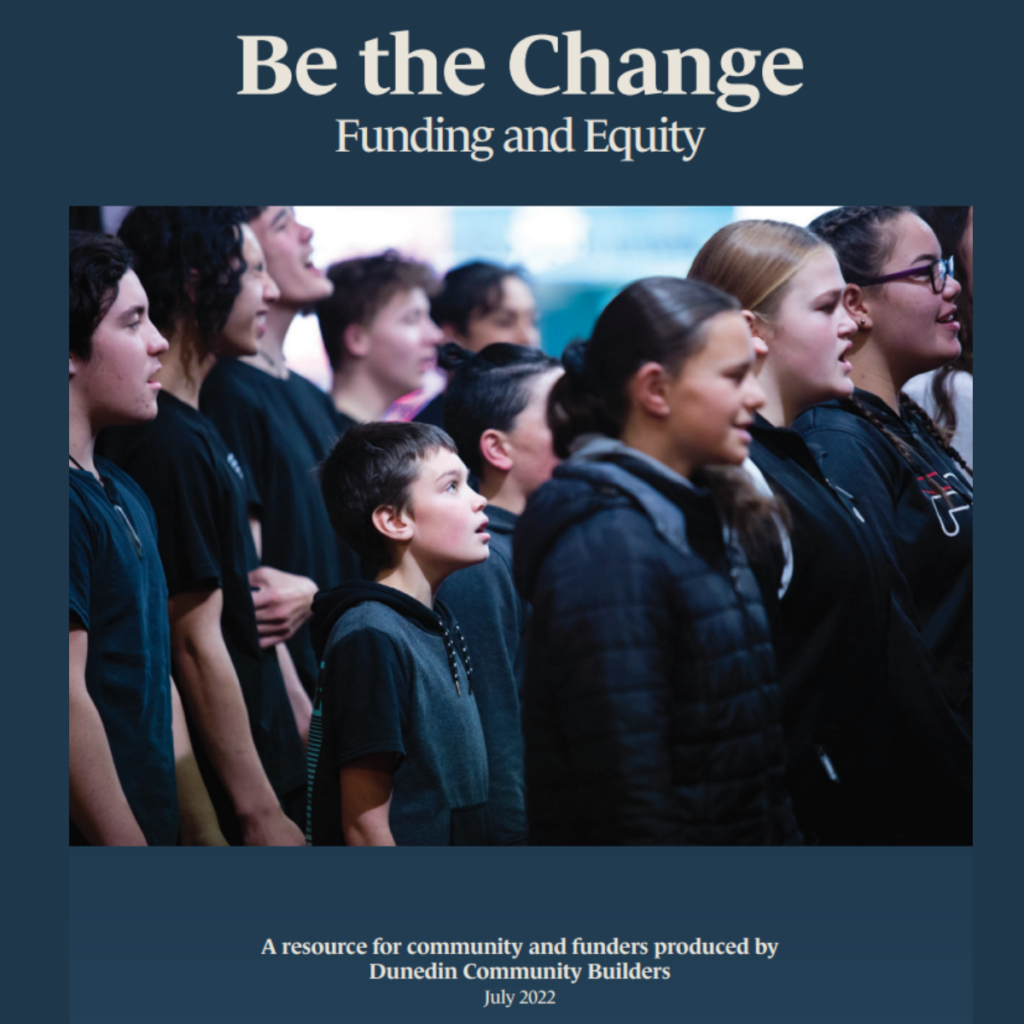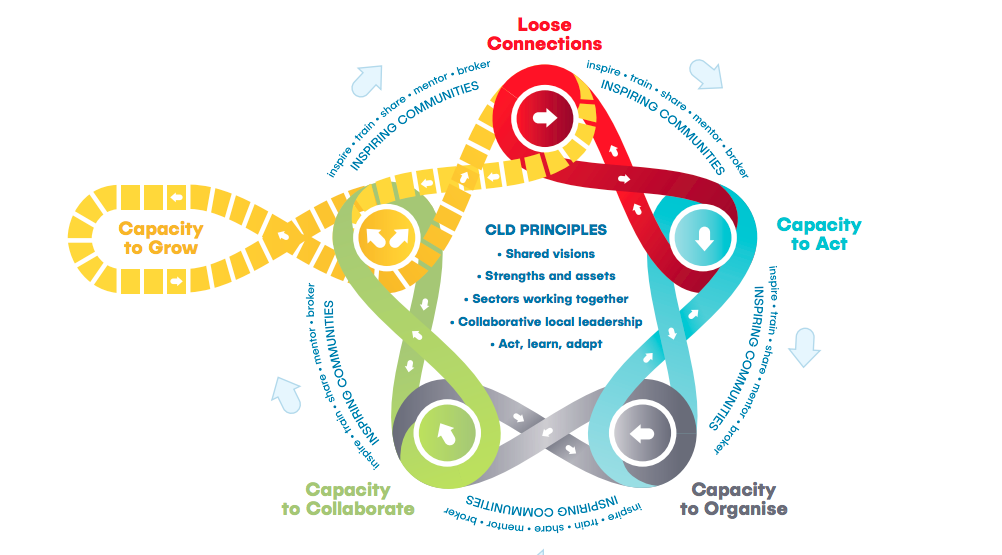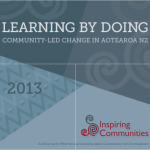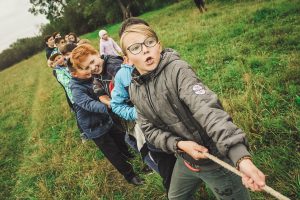Centring equity and place-based approaches in systemic transformation
This paper was co-produced by an international community of practice Inspiring Communities is part of. Our four organisations each support place-based transformation in Australia, Canada, New Zealand and the UK. We come together regularly to share our work, find common ground in many challenges as well as discovering many new ideas and sources of inspiration.
We are:
Collaboration for Impact, Australia
Tamarack Institute, Canada
Inspiring Communities, New Zealand
Place Matters, UK
Be the Change – Funding and Equity
Be the Change is a resource distilled from the kōrero that we have heard from across the community and funding sectors over the last two years and more. It centres the stories and experiences of the Dunedin community and offers the ‘how to’ of funding for change and equity.
DUNEDIN COMMUNITY BUILDERS

National Action Plan for Community Governance
The community sector (NFPs, charities, NGOs and community groups) provides so much for our country.
This Action Plan aims to contribute solutions to the pressures and opportunities that present themselves from a governance point of view across the community sector, and thereby strengthen the sector to continue to deliver vital services, now more than ever.
Me Mahi Tahi Tātou – Working Together
This workbook was written after two Auckland CLD initiatives partnered with Inspiring Communities to trial a Leaderful Communities Workshop process. Called Me Mahi Tahi Tātou – Working Together, it explored community leadership as well as how to build collaborative leadership skills and capacity.
A number of insights were identified over the four sessions which have formed the workbook Me Mahi Tahi Tātou:
- It is important to be invited to a workshop by someone who is known and trusted
- Diverse backgrounds and experiences brought diverse expectations
- Common aspirations include learning new skills, gaining a better understanding about leadership and meeting others from their communities in similar situations.
- Using lots of local examples helps make it real for people
Inspiring Communities Publication, Learning by Doing has a chapter dedicated to Leading in and leaderful communiites
Leadership as Learning Framework
Ehara taku toa i te toa takitahi. Engari, he toa takatini
Success comes from the strength of the collective, not of the lone individual
What if we saw a leader’s role as creating the conditions for everyone to play a part, rather than expecting leaders to know or carry everything? This resource is designed to help you:
- Question your assumptions about leadership
- Identify some common foundations to help encourage the diversity of people, pathways, projects and processes supporting effective CLD
- Work with constant change and adaptation
- Consider what you can do to grow
- your own leadership
- the leadership of others around you
- the leadership of organisations you work in
- the leadership of communities you live and work in
The Working Together Continuum
Understanding different kinds of working relationships is crucial to getting the most out of key stakeholders within your community. From local government, to businesses, to residents, to funders and everyone in between, having an understanding of the types of working relationships you’re likely to encounter – and which ones you will strive to have – will only strengthen your ability to connect with people community-wide.
This explanatory document will introduce you to the types of relationships and their characteristics and allow you to constructively plan ways of communicating and bringing people together to work within these relationship types. It might also encourage you to move a working relationship along the continuum, because it’s important to note that partnering isn’t necessarily the ultimate goal for every relationship.
Also, this worksheet may be useful to print and use in mapping out current and intended relationships.
Child Rich Communities Principles
The overarching goal of the Child Rich Communities (CRC) project is to grow a movement of people who think and work in community-led ways to improve child, family and whānau well-being.
About Child Rich Communities
It’s well known that here in Aotearoa there are big issues when it comes to the wellbeing of our children. We think one part of the jigsaw is changing not just policies, but how we approach issues. It seems clear that the way we’re addressing issues isn’t always working: many of the big issues have been with us for a while, through successive governments, different policies and multiple reforms. So where do we go?
Well, as the quote goes, you can’t do the same thing over and over again and expect a different result. So how about we focus on doing things differently?
Rather than top-down approaches, we believe big change comes from supporting communities to lead. This means supporting communities to decide what solutions will work best for them, sharing power, decision-making and resources to enable locally-led responses and action. This is what Child Rich Communities are all about.
There is no single model or definition for what a Child Rich Community is. Rather it’s a way of working that is driven by a set of principles that enable people in local places to make positive changes for themselves, their children, their family and the wider community.
A movement takes people, so this is where you come in! We’re currently focused on raising the profile of Child Rich Communities and supporting and connecting like-minded people, organisations and initiatives across Aotearoa so that we can all learn from each other.
Does this sound like something you’re interested in? Get in touch and join us. Or if all of this sounds like what you’re currently doing in your community, we’d love to tell your story. Contact Lisa Woods, lisa.woods@inspiringcommunities.org.nz, 021 1228 273.L
Watch some of the Bright Spot communities
Check out locals leading change in their communities. Hear their stories and share their insights into the rewards and challenges of using community-led approaches to support children and families.
About community led development
You an also check out our Bright Spots webinar from 2017. In this webinar, we examined three lessons that emerged from the Bright Spots report. Lizzie McMillan from Wesley Action Waitangirua and Jenny Jurgens from Whanganui Central Baptist Kindergarten provided great case studies to demonstrate these learnings in practice.
Background
Project History
In the past few years, there has been increasing concern about child poverty in New Zealand. The agencies behind this project noticed that the responses to struggling children tend to fit within two strands of work – lobbying and advocacy and targeted intervention by Government, NGOs and the private sector.
Both of these strands of work are important.
However, there is another strand of work that is not always so visible, but is equally important – there are many people working in community-led ways throughout Aotearoa New Zealand. And this work is improving the lives of children and their families.
The aim of this project is to connect and learn from these ‘Bright Spots’ and build support for the role of community led development in child wellbeing.
In early 2015 the organisations – Inspiring Communities, Plunket, UNICEF and Every Child Counts – came together to begin a project to explore local community initiatives that are making a positive difference to children and families.
First step: The report – Child Rich Communities
To kick-start this project, a report was commissioned to explore Bright Spots across Aotearoa New Zealand. A total of 21 initiatives ranging in size and scale, age, geography and entity type were engaged to learn more about their success factors. Stakeholders from philanthropic and government sectors were also interviewed.
Case Studies
What we did next: Bright Spots Hui
Following the release of the report, the project team asked Bright Spots if there was interest in continuing to grow the project. The response was positive, so a hui was organised in November 2016 for the Bright Spots to get together. The aim was to continue learning from one and another and to discuss where to from here for the Child Rich Communities project.
The hui was a fantastic day of story telling, learning and connecting. At the end of the day a set of actions were agreed to guide the next steps. There was a clear desire to grow community-led ways of working through:
- More funding for community-led development groups and initiatives
- Participatory democracy in local communities
- Community mentors to help with child rich communities methods/practice
- Supporting parents and families, e.g. support to enable parents to be home with their children longer
Where we’re at now: Growing Child Rich Communities
We have gratefully received funding from S.K.I.P to resource some of the actions from the hui. The funding enabled us to hold three new webinars (2018), three regional training workshops and set up four new regional ‘communities of practice’ aimed at peer-led support for those active in the community-led development/child well-being space.
While this new funding is specific to these activities, we’re keen to continue work on the wider aim of the project to raise awareness, deepen understanding and promote the role of community-led development in child and family well-being.
A movement takes people, so this is where you come in! We’re currently focused on raising the profile of Child Rich Communities and supporting and connecting like minded people, organisations and initiatives across Aotearoa so that we can all learn from each other. If this sounds like something you’re doing or interested in, get in touch!
The CLD Capability Framework
Over the last decade Inspiring Communities has been learning about what effective practice looks like and the kinds of skills and capabilities required to do this work well. This knowledge has been brought together in a new Community-Led Development Capability Framework for Aotearoa.
The framework is designed to help name values, qualities, skills, knowledge, behaviours and attitudes that are useful to have, learn or amplify to support sustainable change in communities.
Have a look at some or all of this report and see how you might use it to help with reflection, planning, recruitment and capacity building for your organisation or initiative.
How do we do this work when everything keeps changing?
It’s a reality of the world we live in: things around us are constantly evolving. Things don’t always go plan.
In our place we see residents come and go, different policy-makers, changes to infrastructure, key stakeholders alternate. So what can we do?
First of all it’s vital to recognise that we must all be prepared to keep learning and to keep adapting our approaches and responses.
Second of all, if we listen and can identify where the energy, resources, risks and opportunities are.
The Eco-cycle Framework helps us make sense of what we are noticing by drawing on metaphors and research from the natural sciences. Imagine you are looking after a forest; working with the different seasons, weather patterns, soil conditions, fires and storms that come through.
Check this resource out and see what new insights it offers you in working with the different seasons of your community.
How does sustainable change happen?
Over years of learning from the collective wisdom of communities across Aotearoa, we’ve developed our own theory about how sustainable change happens using a community-led development approach.

This theory is grounded in practical experience with the purpose of guiding effective action.
All communities have the ability to thrive, but effective change is dynamic, messy and complex. There is no perfect plan! Our theory of change outlines the phases of change and the transitions between them. Please share this theory and use it as a resource in your work. Let us know what you think.
The Quadrants of Change framework is another framework that we have found really useful in our CLD work. To achieve sustainable change in communities, there are four key dimensions of change to consider: personal, relational, structural and cultural. Any successful and lasting community-change work needs to tap into each area over the course of the change process.



